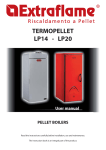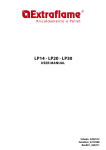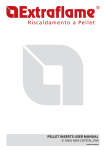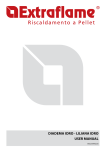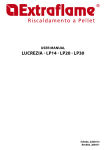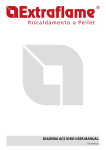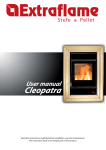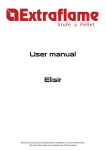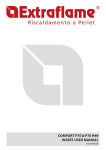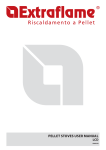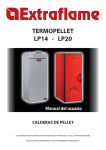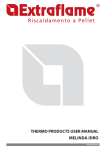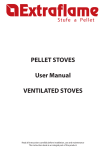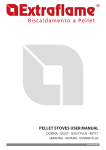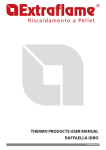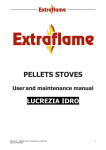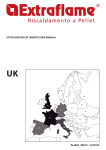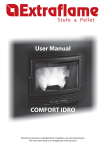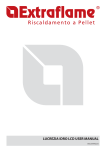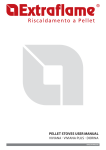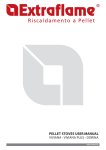Download Chapter 7
Transcript
TERMOPELLET LP14 - LP20 User manual PELLET BOILERS Read the instructions carefully before installation, use and maintenance. The instruction book is an integral part of the product. 2 Congratulations! You are now the owner of an Extraflame boiler The Extraflame boiler is a great heating solution developed from the most advanced technology with top quality machining and modern design, aimed at making you enjoy the fantastic sensation that the heat of a flame gives, in complete safety. This manual will help you to use your boiler correctly. I must be read with great attention before use. IMPORTANT Make sure that your dealer fills the space in that is dedicated to your authorised specialist. He will help you with pleasure if you should have problems using your new boiler. AUTHORISED SPECIALIST COMPANY __________________________________________________________________ Mr. ________________________________________________________________________ STREET NAME __________________________________________N°. __________________ Post code _______ TOWN/CITY _________________ COUNTY ______________________ TELEPHONE _________________________ FAX __________________________________ All Extraflame products are built in compliance with the following Directives: 89/106 EEC (Construction Products) 89/366 EEC (EMC Directive) 2004/108 CE (EMC Directive) 2006/95 CE (Low Voltage Directive) and the Standards: EN 60335-1 EN 60335-2-102 EN 61000-3-2 EN 61000-3-3 EN 50366 EN 55014-1 EN 55014-2 EN 303-5 3 4 Index Chapter 1 WARNINGS AND SAFETY DEVICES.......................................................................................................... 7 Chapter 2 TECHNICAL FEATURES ............................................................................................................................. 9 Chapter 3 THE FUEL .................................................................................................................................................. 12 PELLET FEEDING ............................................................................................................................................................ 12 Chapter 4 SAFETY DEVICES ..................................................................................................................................... 13 FLUE EXHAUST BREAKAGE ............................................................................................................................................... 13 PELLET FEED MOTOR STOP .............................................................................................................................................. 13 DOOR MICRO SWITCH ........................................................................................................................................................ 13 NO IGNITION........................................................................................................................................................................... 13 TEMPORARY POWER CUT ................................................................................................................................................. 13 ELECTRIC SAFETY ................................................................................................................................................................. 13 FLUE EXHAUST SAFETY DEVICE .................................................................................................................................... 13 PELLET TANK TEMPERATURE SAFETY VIA 85°C BULB ............................................................................................ 13 WATER OVERHEATING SAFETY VIA 100° C BULB...................................................................................................... 14 MINIMUM AND MAXIMUM PRESSURE PRESSURE SWITCH ................................................................................. 14 DEVICES NOT ON THE LIST ............................................................................................................................................... 14 INSTALLATION AND SAFETY DEVICES ......................................................................................................................... 14 SAFETY DEVICES FOR CLOSED VESSEL PLANT ......................................................................................................... 14 DISTANCES OF SAFETY DEVICES ACCORDING TO THE STANDARD ................................................................. 15 AUTOMATIC THERMOSTATIC MIXER VALVE (MANDATORY) ................................................................................ 15 TABLE OF SAFETY DEVICES FOR CLOSED VESSEL SYSTEM AND NOT PRESENT IN THE PRODUCT ..... 16 Chapter 5 ASSEMBLY AND INSTALLATION INSTRUCTIONS................................................................................. 19 GLOSSARY ............................................................................................................................................................................... 19 INSTALLATION........................................................................................................................................................................ 20 ALLOWED INSTALLATIONS ........................................................................................................................................ 20 INSTALLATIONS NOT ALLOWED .............................................................................................................................. 20 CONNECTION TO THE SMOKE EVACUATION SYSTEM ........................................................................................... 21 SMOKE CHANNEL OR CONNECTIONS ................................................................................................................... 21 CHIMNEY OR INDIVIDUAL FLUE............................................................................................................................... 22 APPLIANCE CONNECTION TO THE FLUE AND FUEL PRODUCTS EVACUATION .................................... 24 CHIMNEY CAP ................................................................................................................................................................. 24 CONNECTION TO EXTERNAL AIR INLETS .................................................................................................................... 25 INSULATION, FINISHINGS, COVERING AND SAFETY RECOMMENDATIONS ................................................. 25 NATIONAL, REGIONAL, PROVINCIAL AND TOWN COUNCIL REGULATIONS ................................................. 25 Chapter 6 HYDRAULIC SYSTEM ............................................................................................................................... 26 TYPE OF SYSTEM ................................................................................................................................................................... 26 CLOSED VESSEL SYSTEM FOR AUTOMATIC LOADING APPLIANCES ......................................................... 26 GENERALITY ..................................................................................................................................................................... 26 5 FEEDING WATER FEATURES ....................................................................................................................................... 27 FILLING THE PLANT ....................................................................................................................................................... 27 Chapter 7 PRODUCT FUNCTIONALITY ................................................................................................................... 28 CONTROL BOARD ................................................................................................................................................................. 28 LANGUAGE SELECTION ...................................................................................................................................................... 29 CURRENT DAY AND TIME ADJUSTMENT ..................................................................................................................... 29 MODE ........................................................................................................................................................................................ 30 MODE SELECTION ......................................................................................................................................................... 31 WINTER MODE ......................................................................................................................................................... 31 WINTER-DOMESTIC MODE.................................................................................................................................. 31 SUMMER MODE ....................................................................................................................................................... 31 SAFETY ZONE ......................................................................................................................................................................... 31 EXTERNAL THERMOSTAT FUNCTION IN STBY/TOFF” MODE .............................................................................. 32 FUNCTIONING CYCLE ......................................................................................................................................................... 33 BASIC INSTRUCTIONS .................................................................................................................................................. 33 IGNITION ........................................................................................................................................................................... 33 START-UP .......................................................................................................................................................................... 34 FUNCTIONING ................................................................................................................................................................. 34 SWITCH-OFF..................................................................................................................................................................... 35 WATER TEMPERATURE ADJUSTMENT........................................................................................................................... 35 THERMOSTATS CONNECTION ......................................................................................................................................... 35 WINTER MODE OUTPUT BOARD MANAGEMENT....................................................................................... 36 WINTER DHW MODE OUTPUT BOARD MANAGEMENT ........................................................................... 36 SUMMER MODE OUTPUT BOARD MANAGEMENT .................................................................................... 36 Chapter 8 USER PARAMETERS ................................................................................................................................ 37 WEEKLY PROGRAMMER ..................................................................................................................................................... 37 PELLET FEED ADJUSTMENT ............................................................................................................................................. 40 SPRINGS AUTOMATIC CLEANING TIMES ..................................................................................................................... 41 Chapter 9 BOILER CLEANING ................................................................................................................................. 42 BRAZIER CLEANING ............................................................................................................................................................. 42 SPRING CLEANING ............................................................................................................................................................... 42 DOOR AND ASH DRAWERS GASKETS ........................................................................................................................... 43 CONNECTION TO THE FLUE .............................................................................................................................................. 43 Chapter 10 PRODUCT DISPLAY TABLES ................................................................................................................... 44 WARRANTY CONDITIONS ...................................................................................................................... 48 QUALITY CONTROL ................................................................................................................................. 49 6 Chapter 1 WARNINGS AND SAFETY DEVICES INTRODUCTION The boilers produced by our establishment are built with attention to the individual components in a way to protect both the user and the installer from any accidents. It is therefore recommended that after any intervention on the product, that authorised staff pays particular attention to the electric connections, especially the stripped parts of the wires. These must not escape from the terminal board in any situation, thus preventing possible contact with the live parts of the wire. The instruction manual is an integral part of the product: make sure that it always accompanies the appliance, even if transferred to other owners or user or is transferred to another place. If it is damaged or lost, request another copy from the area technician. This boiler must be destined for the use for which it has been expressly realised. The manufacturer is exempt from any liability, contractual and extracontractual, for injury/damage caused to persons/animals and objects, due to installation, adjustment and maintenance errors and improper use. INSTALLATION Installation of the boiler and auxiliary equipment in relation to the heating system must comply with all current Standards and Regulations and to those envisioned by the law. Installation must be carried out by authorised staff, which must provide the buyer with a declaration of conformity for the system and will assume full responsibility for final installation and as a consequence the correct functioning of the installed product. It is necessary to bear in mind all laws and national, regional, provincial and town council Standards present in the country the appliance has been installed. Extraflame S.p.A. cannot be held responsible for the failure to comply with such precautions. Before installation, wash the pipes of the system well in order to remove any residues that could compromise the correct functioning of the appliance. During installation, inform the user regarding: a. In case of water leaks, he must close the water supply and promptly warn the after-sales technical service. b. The system working pressure must be checked periodically. If the boiler is not used for a long period of time, it is recommended that the after-sales technical service is contacted to carry out at least the following operations: - Position the master switch on position 0. - Close the water taps of both the heat system and the domestic hot water system; - Empty the heating system and the domestic hot water system if there is risk of freezing. COMMISSIONING After the packaging has been removed, check the integrity and completeness of the contents. If this does not comply, contact the dealer where the appliance was purchased. During commissioning of the product, check the correct functioning of all devices, both safety and control, which make up the boiler. All electrical components that make up the boiler must be replaced with original spare parts exclusively by an authorised after-sales centre, thus guaranteeing correct functioning. Before leaving the system, the staff in charge of commissioning must check boiler functioning for at least one complete work cycle. The boiler must be serviced at least once a year, programming it in advance with the technical after-sales service. WARNINGS AND SAFETY DEVICES 7 Chapter 1 APPROVALS The Extraflame boilers have been designed and realised in compliance with the following Directives: UNI EN 303-5 Boilers for central heating. Boilers for solid fuel, with manual and automatic feeding, with a nominal heat output up to 300 kW Compliance with the Low Voltage Directive (73/23 EEC) Compliance with the EMC Directive (Electromagnetic compatibility 89/336 EEC) FOR SAFETY The boiler must not be used by children or unassisted disabled persons. Do not touch the boiler when you are barefoot or when parts of the body are wet or humid. The safety and adjustment devices must not be modified without the authorisation or indications of the manufacturer. Do not pull, disconnect, twist electric cables leaving the boiler, even if disconnected from the electric power supply mains. Do not close or reduce the dimensions of the airing vents in the place of installation. The airing vents are indispensable for correct combustion. Do not leave the packaging elements within reach of children or unassisted disabled persons. The hearth door must always be closed during normal functioning of the product. Avoid direct contact with parts of the appliance that tend to heat up during functioning. Check for the presence of any obstructions before switching the appliance on following a prolonged standstill period. The boiler has been designed to function in any climatic condition (also critical). In particularly adverse conditions (strong wind, freezing) safety systems may intervene that switch the boiler off. If this occurs, contact the technical after-sales service and always disable the safety system. If the flue should catch fire, be equipped with suitable systems for suffocating the flames or request help from the fire service. If the boiler should block, indicated by a signal on the display and that is not relative to lack of routine maintenance, contact the technical after-sales centre. USE These boilers must be used to heat water to a temperature that does not exceed boiling point in the conditions of installation. 8 WARNINGS AND SAFETY DEVICES Chapter 2 TECHNICAL FEATURES Features Weight Height Width Depth Flue exhaust pipe diameter Air intake pipe diameter Max. global heat output Max. useful heat output (to the water) Minimum global heat output Min. useful heat output Max. hourly fuel consumption Min. hourly fuel consumption Feed-box capacity Recommended flue draught Nominal electric output Appliance electrical power Nominal voltage Nominal frequency Water inlet/outlet pipe diameter Automatic exhaust pipe diameter Pump head Max. working water pressure accepted Min. working water pressure accepted kg mm mm mm mm mm kW kW kW kW kg/h kg/h kg Pa W W Vac Hz “ “ m bar bar LP 14 LP 20 220 1327 533 663 120 60 15.3 14.0 4.3 3.9 3.3 1.0 ~ 43 ~ 10 970 470 230 50 1 1/2 5 2.5 0.6 260 1368 525 941 120 60 22.0 21.0 4.4 4.2 4.7 1.0 ~ 70 ~ 10 970 470 230 50 1 1/2 5 2.5 0.6 Tests performed using wooden pellets as fuel, certified according to ONORM M7135 DIN PLUS. The data given above is indicative and not binding. The manufacturer reserves the right to make any modifications in order to improve product performance. TECHNICAL FEATURES 9 Chapter 2 LP 14 1327 41 46 533 E C 370 D 187 105 B A 121 261 103 663 166 77 A = AIR INTAKE PIPE Ø 50 mm B = FLUE GAS EXHAUST PIPE Ø 120 mm C = BOILER 1 “ FLOW/OUTLET D = BOILER 1 “ RETURN/INLET E = 3 BAR 1/2 “ SAFETY DRAIN 533 figure 2.1 10 TECHNICAL FEATURES Chapter 2 LP 20 525 74 292 187 662 708 750 B 1368 E C D A 119 74 100 941 163 A = AIR INTAKE PIPE Ø 50 mm B = FLUE GAS EXHAUST PIPE Ø 120 mm C = BOILER 1 “ FLOW/OUTLET D = BOILER 1 “ RETURN/INLET E = 3 BAR 1/2 “ SAFETY DRAIN 525 figure 2.2 TECHNICAL FEATURES 11 Chapter 3 THE FUEL Pellets are realised by subjecting wood shavings i.e. the rejects of pure wood (without paint) sawmill, carpenter products and products from other activities connected to working and transforming wood, to very high pressures. This type of fuel is absolutely ecological as no glues are used to hold it together. In fact, the compactness of the pellets is guaranteed through time by a natural substance that is found in wood: lignin. As well as being an ecological fuel, as wood residues are made the most of, the pellet also has technical advantages. Pellet density is about 650 kg/m3 and water content is equal to 8% of its weight. For this reason the pellet does not have to be seasoned in order to obtain a sufficiently adequate heat yield. The pellet used must comply with the features described by the Standard: Ö-Norm M 7135 DIN plus 51731 UNI CEN/TS 14961 Extraflame recommends the use of pellets with a diameter of 6mm with its products. ATTENTION ! THE USE OF EXPIRED PELLETS OR ANY OTHER MATERIAL DAMAGES THE FUNCTIONS OF YOUR PRODUCT AND CAN DETERMINE THE INVALIDITY OF THE WARRANTY AND THE ANNEXED RESPONSIBILITY OF THE MANUFACTURER. PELLET FEEDING During first product use, feed the pellet inside the tank, as illustrated in the figure, until completely full. figure 3.1 N.B. It is important to periodically check the residue pellet inside the tank to avoid it finishing completely, which results in the boiler switching off. WARNINGS The use of expired pellets or any other unsuitable material can damage certain boiler components and jeopardise its correct functioning: this can determine the invalidity of the warranty and the relative responsibility of the manufacturer. Extraflame invites the user to use pellet in compliance with the described features and the Standards in force. 12 THE FUEL Chapter 4 SAFETY DEVICES FLUE EXHAUST BREAKAGE If the suction device stops, the electronic board immediately blocks the pellet supply. PELLET FEED MOTOR STOP If the motor reducer stops for any reason, the machine goes into alarm mode and the fumes motor continues to function in order to expel all combustion gas until the minimum cooling level is reached. DOOR MICRO SWITCH (see figure 4.5) When the product door is opened, a safety micro switch blocks fuel feeding. NO IGNITION If a flame is not developed during the ignition phase, the appliance will go into no ignition alarm mode. TEMPORARY POWER CUT If the power cut is less than 10 seconds, normal functioning will continue when the current returns. If the power cut is longer than 10 seconds, the “black out” alarm will occur when the current returns, taking the product to complete cooling. When cooling has ended it will re-start in automatic mode. ELECTRIC SAFETY The stove is protected against strong current changes by a master fuse that is found in the rear part of the stove. (2.5A 250V Delayed). FLUE EXHAUST SAFETY DEVICE An electronic pressure switch blocks stove functioning and takes it to alarm conditions. PELLET TANK TEMPERATURE SAFETY VIA 85°C BULB (see figure 4.7) If there is overheating inside the feed-box this device blocks pellet feed motor functioning; restoration is manual and must be performed by an authorised technician. The restoration of 85°C safety device is not under warranty unless the after-sales centre can show the presence of a faulty component. SAFETY DEVICES 13 Chapter 4 WATER OVERHEATING SAFETY VIA 100° C BULB (see figure 4.3) When the temperature of the water inside the product is in proximity of 100°C, pellet feeding is blocked. If the bulb trips, restoration of the safety device is manual and must be performed by an authorised technician. The restoration of 100°C safety device is not under warranty unless the after-sales centre can show the presence of a faulty component. MINIMUM AND MAXIMUM PRESSURE PRESSURE SWITCH (see figure 4.6) A minimum and maximum pressure pressure switch is installed in series with the pellet motor electric power supply. If the pressure in the system is below 0.6 bar, the electric power supply is blocked to the pellet feed motor. If the pressure in the system exceeds 2.5 bar, manual rearm of the pressure switch is triggered: restoration of the safety device is manual and must be performed by an authorised technician. Attention: any presence of air in the system could cause the minimum or maximum pressure pressure switch to intervene. If the minimum pressure pressure switch intervenes blocking pellet feed into the machine, alarms may occur connected to the lack of fuel. ATTENTION ! For regular functioning of the product an ideal system pressure of 1.1 bar is recommended (cold system). Moreover, there must be no air in the system. Extraflame recommends the installation of suitable air vent devices in the system. Any air venting operations from the system or the product is not covered by the warranty. DEVICES NOT ON THE LIST During installation of the stove it is MANDATORY to insert a manometer into the system in order to display the water pressure. INSTALLATION AND SAFETY DEVICES The installation, relative plant connections, commissioning and inspection of correct functioning must be carried out perfectly, in total compliance with Standards in force, both national and regional, as well as these instructions. For Italy, installation must be carried out by professionally authorised staff (Ministerial Decree dated 22.01.08 n°37). Extraflame S.p.A. declines all responsibility for damages to objects and/or persons caused by the plant. SAFETY DEVICES FOR CLOSED VESSEL PLANT According to the UNI 10412-2 (2006) Standard in force in Italy, the closed plants must have: Safety valve Pump control thermostat Acoustic alarm activation thermostat 14 SAFETY DEVICES Chapter 4 Temperature indicator Pressure indicator Acoustic alarm Adjustment automatic circuit breaker switch Automatic circuit breaker switch (block thermostat) Circulation system Expansion system Safety dissipation system incorporated with the generator with thermal safety valve (self-activated), whenever the appliance does not have a temperature self-adjustment system DISTANCES OF SAFETY DEVICES ACCORDING TO THE STANDARD Component Distance Temperature safety sensors On the machine or not exceeding 30 cm Devices missing because not standard (see table Not exceeding one metre, on the flow pipe on next page) The temperature safety sensors must be in place on the machine at a distance no greater than 30 cm from the flow connection. Whenever the generators lack a device, those missing can be installed on the thermo product flow pipe, within a distance no greater than 1m from the machine. The domestic heating appliances with automatic feeding must: be equipped with a fuel block thermostat (figure 4.1, 4.3), or be equipped with a cooling circuit prepared by the manufacturer of the appliance. The cooling circuit must be activated by a heat safety valve such to guarantee that the limit temperature set by the Standard is not exceeded. Connection between the power supply unit and the valve must be free from interceptions. The pressure upstream from the cooling circuit must be at least 1.5 bar. AUTOMATIC THERMOSTATIC MIXER VALVE (MANDATORY) The automatic thermostatic mixing valve is applied in solid fuel boilers as it prevents cold water return in the exchanger (figure 4.8). Routes 1 and 3 are always open and, together with the pump installed on the return, they guarantee water circulation inside the biomass boiler exchanger. An elevated return temperature, allows efficiency improvement, reduces formation of smoke condensation and prolongs the boiler life span. Valves on the market have different calibrations. Extraflame advises use of model 55°c with 1” hydraulic connections. Once the valve calibration temperature is reached, route 2 is opened ad the boiler water goes to the system via the flow. Extraflame recommends not to use this device whenever the DHW is produced through an instant heat exchanger. SAFETY DEVICES 15 Chapter 4 TABLE OF SAFETY DEVICES FOR CLOSED VESSEL SYSTEM AND NOT PRESENT IN THE PRODUCT Safety valve Pump control thermostat Acoustic alarm activation thermostat Temperature indicator Pressure indicator Acoustic alarm Adjustment automatic circuit breaker switch Water overheating automatic circuit breaker block switch (block thermostat) Circulation system Expansion system Safety dissipation system incorporated with the generator with thermal safety valve (selfactivated), whenever the appliance does not have a temperature self-adjustment system * * (managed by H2O probe and board firmware) * (display) * (board firmware) * Figure 4.1 4.1 4.3 * 4.2 * 4.4 Not necessary as the machine has a t° self-adjusting system and a block automatic circuit breaker switch. As per standard (*) Not as per standard (-) air vent valve 3 bar valve pressure switch H2O NTC probe figure 4.1 16 figure 4.2 SAFETY DEVICES Chapter 4 Rearm of the H2O 100° C overheating mechanical bulb 6 litre expansion vessel figure 4.3 Enlarged detail of the door safety micro switch figure 4.5 figure 4.4 Pressure switch (detail): maximum pressure micro switch figure 4.6 Pressure switch: minimum pressure micro switch rearm of the 85°C pellet tank overheating mechanical bulb figure 4.7 SAFETY DEVICES 17 Chapter 4 Safety valve discharge Thermometer Manometer Flow 3 1 2 Return ESBE 55°C Filling system figure 4.8 18 SAFETY DEVICES Chapter 5 ASSEMBLY AND INSTALLATION INSTRUCTIONS The installation must comply with: UNI 10683 (2005) heat generators fed with wood and other solid fuels: installation. The chimneys have to be in compliance with: UNI 9731 (1990) chimneys: classification based on thermal resistance. EN 13384-1 (2006) chimneys thermal and fluid-dynamics calculation method. UNI 7129 point 4.3.3 Fire Department dispositions, local rules and prescriptions. UNI 1443 (2005) chimneys: general requisites. UNI 1457 (2004) chimneys: terracotta and ceramic inside pipes. GLOSSARY CLOSED HEARTH APPLIANCE Heat generator which opening is only allowed through the loading of the fuel during use. BIOMASS Biological material, excluding the material incorporated in geological formation and transformed in fossil. BIOFUEL Fuel produced directly or indirectly by biomass. CHIMNEY Vertical pipe with the aim to collect and expel, at a convenient height from the ground, the fuel products coming from only one appliance. SMOKE CHANNEL OR CONNECTION Pipe or connecting element between heat generator appliance and chimney to evacuate fuel products. INSULATION Together of devices and materials used to prevent the transmission of heat through a wall which separates rooms with different temperature. CHIMNEY CAP Device positioned at chimney peak to ease the dispersion of fuel products in the atmosphere. CONDENSATION Liquid products which form when the fuel gas temperature is lower or equal to the water dew point. HEAT GENERATORS Appliance which allows to produce thermal energy (heat) through the rapid transformation, through combustion, of the chemical energy of the same fuel. GATE VALVE Mechanism to amend the fuel gas dynamic resistance. ASSEMBLY AND INSTALLATION INSTRUCTIONS 19 Chapter 5 SMOKE EVACUATION SYSTEMS Flue gas exhaust system independent from the appliance constituted by a fitting or smoke channel, chimney or individual flue and chimney cap. FORCED DRAUGHT Air circulation by means of the fan activated by electric motor. NATURAL DRAUGHT Draught which determinates in a chimney/flue for effect of the volume mass difference existing between smoke (hot) and surrounding atmosphere air, without any mechanical intake aid installed inside it or at its peak. RADIATION AREA Area immediately near the furnace in which the heat caused by combustion is diffused, where there must be no fuelling materials. REFLUX AREA Area where leaking of the fuel products is verified, from the appliance towards the installation room. INSTALLATION The installation must be preceded by checking the chimneys, flues or unload terminals positioning of appliances similarly to: No installation Legal distances Limitations disposed by local administrative regulations or particular authority prescriptions. Conventional limitations deriving from apartment building, constraints or contracts. ALLOWED INSTALLATIONS Only appliances working softly respect to the room or which do not place the room in depression respect to the external environment, can exist or be installed in the room where the heat generator will be installed. Only in rooms for kitchen use are appliances for cooking food and relative hoods without extractor. INSTALLATIONS NOT ALLOWED In the room where the heat generator will be installed the following must not pre-exist or be installed: hoods with or without extractor; collective type ventilation pipes. Should these appliances be in rooms adjacent, communicating with the installation room, the simultaneous use of the heat generator is forbidden, where a risk exists of one of the two rooms being placed in depression respect to the other. 20 ASSEMBLY AND INSTALLATION INSTRUCTIONS Chapter 5 CONNECTION TO THE SMOKE EVACUATION SYSTEM SMOKE CHANNEL OR CONNECTIONS To mount the smoke channels, non-flammable elements will have to be used, ideal for resisting fuel products and their eventual condensing. The use of flexible metal and asbestos cement pipes to connect the appliances to the flue is forbidden, even for pre-existing smoke channels. There must be continuity between the smoke channel and the flue so that the flue does not lean on the generator. The smoke channels must not cross rooms where the installation of the combustion appliances is not allowed. The mounting of the smoke channels must be carried out in order to guarantee smoke seal for the appliance functioning conditions, limit the forming of condensate and avoid it being transported towards the appliance. The mounting of horizontal routes must be avoided. For appliances where ceiling or wall non coaxial discharges respect to the appliance smoke outlet have to be reached, the direction changes will have to realised using open elbows not higher than 45° (see figures below). Insulating product < 45° < 45° Flue Inspection figure 5.1 figure 5.2 For the heat generator appliances equipped with electric fan for expelling fumes, the instructions below must be followed: The horizontal routes will have to have a minimum upward slope of 3% The length of the horizontal route must be minimal and, however, not higher than 3 meters The number of direction changes including the one for effect of using the “T” element must not be more than 4 (if 4 bends are used, use double wall piping with an internal diameter of 120 mm.) In any case, the smoke channels must seal the fuel and condensing products and be insulated if they pass externally to the installation room. The use of counterslope elements is forbidden. The smoke channel must allow the recovery of soot or be brushed. The smoke channel must be at constant section. Any section changes are only allowed at the flue coupling. ASSEMBLY AND INSTALLATION INSTRUCTIONS 21 Chapter 5 It is forbidden to have other air supply channels and pipes for plant engineering, especially if over-sized, transit inside the smoke channels. The mounting of manual draught adjustment devices on forced draught appliances is forbidden. CHIMNEY OR INDIVIDUAL FLUE B B The chimney or individual flue must respond to the following requisites: seal the fuel products, waterproof and adequately insulated similarly to the use conditions; be realised with materials which resist the normal mechanical stresses, heat, action of the fuel products and any condensing; have mainly vertical progress with deviations from the axis not higher than 45°; be adequately distanced from fuel or flammable materials through air space or opportune insulation; A 530 mm A 663 mm C C 663 mm A figure 5.3 530 mm A figure 5.4 REFERENCES A 500 mm B 1000 mm C 1000 mm have preferably circular internal section: the square or rectangular sections must have round corners with a radius not lower than 20 mm; have constant internal section, free and independent; have rectangular section with max. ratio between the sides of 1.5. It is recommended that the smoke pipe be equipped with a collection chamber for solid materials and any condensing situated under the smoke channel inlet, so that it can be easily opened and inspected from airtight door. 22 ASSEMBLY AND INSTALLATION INSTRUCTIONS Chapter 5 Chimney cap Wind-proof <3m 3-5% Flue Inspection Inspection figure 5.5 figure 5.6 <3m Insulated external pipe 45° 45° Inspection Inspection figure 5.7 ASSEMBLY AND INSTALLATION INSTRUCTIONS figure 5.8 23 Chapter 5 APPLIANCE CONNECTION TO THE FLUE AND FUEL PRODUCTS EVACUATION The flue must receive the discharge from only one heat generator. The direct discharge towards closed spaces is forbidden, even with clear sky. The direct discharge of the fuel products must be at roof and the smoke pipe must have the features provided in the “Chimney or individual flue” section”. CHIMNEY CAP The chimney cap must comply with the following requisites: have an internal section equivalent to that of the chimney; have useful outlet section not lower than double the chimney internal section; be built in order to avoid rain, snow, foreign bodies penetrating the chimney and in order that, in case of winds in any direction and inclination, the discharge of the fuel products is assured. be positioned in a way to guarantee an adequate dispersion and dilution of the fuel products and, however, outside the reflux area in which the formation of counterpressures occurs. Such area has different dimensions and configuration depending on the covering inclination angle, it is therefore necessary to adopt the minimum heights indicated in the figure layouts below. The chimney cap must not have mechanical intake means. FLAT ROOF 50 cm 50 >5m <5m <5m figure 5.9 SLOPING ROOF Distance > A Distance < A 50 cm over the ridge REFLUX AREA reflux area height H min β figure 5.10 24 ASSEMBLY AND INSTALLATION INSTRUCTIONS Chapter 5 CHIMNEY CAPS, DISTANCES AND POSITIONING Roof Distance between the Minimum chimney height inclination ridge and the chimney (measured from outlet) β A (m) H (m) < 1,85 0,50 m over the ridge 15° > 1,85 1,00 m from roof < 1,50 0,50 m over the ridge 30° > 1,50 1,30 m from roof < 1,30 0,50 m over the ridge 45° > 1,30 2,00 m from roof < 1,20 0,50 m over the ridge 60° > 1,20 2,60 m from roof CONNECTION TO EXTERNAL AIR INLETS The appliance must be able to use the necessary air to guarantee regular functioning through external air inlet. The air inlets must comply with the following requisites: 1. have a total free section of at least 80 cm2. 2. must be protected by grates, metal net or suitable protections as long as they do not reduce the minimum section stated in point 1 and positioned in order to avoid them being obstructed. If the combustion agent air is withdrawn directly from outside through a pipe, a downward bend must be mounted outside or a protection against the wind and no grids or similar must be positioned. (it is recommended that the air vent always communicates directly with the installation room even if the air is withdrawn from outside through a pipe). The air flow can also be obtained from an adjacent room to the installation one, as long as the flow can happen freely through permanent openings communicating with the outside. The adjacent room, respect to the installation one, must not be put in depression respect to the external environment by means of reverse draught caused by the presence of another used appliance or intake device in such room. The permanent openings in the adjacent room must comply with the above-described requisites. The adjacent room cannot be set up as garage, storage for fuelling material or activity with danger of fire. INSULATION, FINISHINGS, COVERING AND SAFETY RECOMMENDATIONS The coverings, independently from the materials with which they are made, must constitute a selfsupporting construction respect to the heating block and not be in contact with it. The wooden or fuelling materials beam and finishings must be positioned outside the hearth radiation area or adequately insulated. In case coverings in fuelling material or sensible to heat exist in the space above the generator, an insulating and non fuelling protection diaphragm must be inserted. Elements in fuelling or inflammable material like wooden furniture, curtains, etc., directly exposed to the hearth radiation, must be positioned at a safe distance. The appliance installation must guarantee easy access for cleaning the same appliance, discharge gas pipe and flue. NATIONAL, REGIONAL, PROVINCIAL AND TOWN COUNCIL REGULATIONS It is necessary to bear in mind all laws and national, regional, provincial and town council Standards present in the country the appliance has been installed. ASSEMBLY AND INSTALLATION INSTRUCTIONS 25 Chapter 6 HYDRAULIC SYSTEM Certain concepts referring to Italian normative UNI 10412-2 (2006) are described in this chapter. As previously described, when installing, all national, regional, provincial and town council Standards in force provided by the country in which the appliance has been installed must be complied with. TYPE OF SYSTEM There are two different types of plant: Open vessel plant and closed vessel plant. The product has been designed and realised to work with closed vessel systems. CLOSED VESSEL SYSTEM FOR AUTOMATIC LOADING APPLIANCES System in which the water it contains is not in direct or indirect communication with the atmosphere. Generally, the closed vessel system has one of the following expansion vessels: Pre-loaded closed expansion vessel with membrane impermeable to the passage of gases. Automatic closed expansion system with compressor and membrane impermeable to the passage of gases. Automatic closed expansion system with transfer pump and membrane impermeable to the passage of gases. Expansion system without diaphragm. GENERALITY The closed plants must have: Safety valve Pump control thermostat Acoustic alarm activation thermostat Temperature indicator Pressure indicator Acoustic alarm Adjustment automatic circuit breaker switch Automatic circuit breaker switch (block thermostat) Circulation system Expansion system Safety dissipation system incorporated with the generator with thermal safety valve (self-activated), whenever the appliance does not have a temperature self-adjustment system The temperature safety sensors must be in place on the machine at a distance no greater than 30 cm from the flow connection. Whenever the generators lack a device, those missing can be installed on the thermo product flow pipe, within a distance no greater than 1m from the machine. Domestic type heating appliances with automatic feed must have a fuel block thermostat or a cooling circuit prepared by the manufacturer of the appliance, activated by a thermal safety valve such as to guarantee that the limit temperature set by the Standard is not exceeded. The connection between the feed unit and the valve must be free from interceptions. The pressure upstream from the cooling circuit must be at least 1.5 bar”. 26 HYDRAULIC SYSTEM Chapter 6 COMMISSIONING CHECKS Before connecting the boiler arrange: a) an accurate washing of all plant piping in order to remove any residues which might compromise the correct functioning of certain plant components (pumps, valves, etc.). b) a check to verify that the flue as adequate draft, is not narrowed and that other appliances do not discharge into the flue. This is to prevent unexpected power increases. Only after this control can the flue fitting be mounted between the boiler and the flue. A check of the connections with pre-existing flues is recommended. FEEDING WATER FEATURES The chemical-physical features of the plant and reinstate water are fundamental for the correct functioning and life-span of the boiler. Amongst the inconveniences caused by bad quality feeding water, the most frequent is the scaling of the thermal exchange surfaces. Less frequent, but equally serious, is the corrosion of the water side surfaces of the entire circuit. It is known that the limescale scalings, even if there are only a few millimetres, due to their low thermal conductivity, greatly reduce the thermal exchange, determining damaging located heating. It is strongly recommended in the following cases to treat the water: a) very hard water available (higher than 20°f ) b) very extended plants c) large water quantities restored due to leaks d) subsequent fillings due to plant maintenance work To treat the feeding water of the heating plants, it is recommended to always contact specialised companies. FILLING THE PLANT Once the hydraulic connections have been carried out, proceed to connecting the plant. Open all air venting valves of radiators, boiler and plant. Gradually open the load cock ensuring that the air venting valves work regularly. Using the manometer, check that the plant is pressurised. In case of closed vessel plant, reach the pressure of about 0.11 – 0.12 MPa (1.1 – 1.2 bar). Close the load cock and again release the air from the boiler through the venting valve. HYDRAULIC SYSTEM 27 Chapter 7 PRODUCT FUNCTIONALITY CONTROL BOARD REMOTE CONTROL SENSOR (not available for this product) D1 D2 figure 7.1 1 D ON/OFF BUTTON By pressing button 1 it is possible to switch the stove on and off automatically. 4-5 D FUNCTIONING POWER The heat power can be adjusted using buttons 4 and 5 Display D1 to view the various messages. Display D2 to view the power set. 28 PRODUCT FUNCTIONALITY Chapter 7 LANGUAGE SELECTION Follow the procedure below to select the desired language: 1. Remove and restore the boiler power supply using the master switch or using the power supply cable. 2. The boiler sequentially displays the following items before reaching “OFF”: Microprocessor version (LP_V8 or successive versions) Mode Selection (WINTER as set in the factory) Language (LANGUAGE) Actual day and time adjustment (CLOCK) Level (LEVEL setting reserved for authorised technicians) 3. When “LANGUAGE” appears, press button 5 to access the adjustment mode. 4. Display D1 will show the language currently selected while display D2 will show “LANG”: use keys 2 and 3 to select the language from those available: ITALIAN - ENGLISH - GERMAN - FRENCH - SPANISH - DUTCH - PORTUGUESE - FINNISH - NORWEGIAN 5. Once the desired language has been selected, press button 1 to escape and confirm. CURRENT DAY AND TIME ADJUSTMENT Controls procedure 1. Remove and restore the stove power supply using the master switch or using the power supply cable. 2. The stove will first display the microprocessor version (LP_V8 or successive), “TIME”, “LI 3” and then “OFF”. 3. When “TIME” appears, press button 5 to access the adjustment mode. 4. Display D1 will show a day of the week (from DAY1 a DAY7): use keys 2 and 3 to set the current day and confirm using button 5. D1 display DAY 1 DAY 2 DAY 3 DAY 4 DAY 5 DAY 6 DAY 7 Meaning Monday Tuesday Wednesday Thursday Friday Saturday Sunday 5. Display D1 will show the current time, the hours flashing while the minutes are fixed: use keys 2 and 3 to adjust the time and then confirm using key 5. 6. At this point the hours will become fixed and the minutes will start to flash: use keys 2 and 3 to adjust the minutes. To go back to selection of the hours, press button 4 again or escape and confirm using button 1. PRODUCT FUNCTIONALITY 29 Chapter 7 MODE The boiler is arranged to receive certain supplementary external thermostats which allow to adapt and adjust the functioning of the same, in relation to the plant requirements. The “Winter”, “DHW Winter” and “Summer” functioning modes are for the use of thermostats. If thermostats are not used, in any mode, machine functioning will remain the same. The external thermostats will be connected to the terminal board located in the boiler rear part. It is the installer’s responsibility to check the adequate earthing of the supplementary device applied on figure 7.2 the boiler. If necessary, provide an additional earthing. Pay particular attention to avoid cables coming into contact with parts in temperature. On the tank rear wall, immediately above the terminal board, there are 4 holes to fix the provided cable glands inside the accessories bag. THERMOSTAT RELATIVE OUTLET INP 1 (T1) OUT 4 INP 2 (T2) OUT 3 CONTACT Closed Open Closed Open MEANING Heat request No heat request Heat request No heat request DISPLAY t1 off in display D2 t1 on in display D2 t2 off in display D2 t2 on in display D2 ING1 (T1) D connection input between clamps ING1 and COM of the terminal board ING2 (T2) D connection input between clamps INP2 and COM of the terminal board The outputs status indicated in the table below and successively are only to be considered valid with the pump working (stove water temperature > anti-condensate threshold). Functioning with standard configuration as set in the factory WINTER MODE State of Clamps State of outputs Boiler status INP1 and INP2 closed OUT4 active (230 V, 50 Hz) (jumpered as in the Boiler on OUT3 active (230 V, 50 Hz) factory) 30 PRODUCT FUNCTIONALITY Chapter 7 MODE SELECTION 1. Remove and restore the boiler power supply using the master switch or using the power supply cable. 2. The boiler sequentially displays the following items before reaching “OFF”: Microprocessor version (LP_V.... or successive versions) Mode Selection (WINTER as set in the factory) Language (LANGUAGE) Current day and time adjustment (CLOCK) Level (LEVEL setting reserved for authorised technicians) 3. When “WINTER” appears, press button 5 to access the adjustment mode. 4. Display D1 will show the mode currently selected while display D2 will show “Mod-”: use keys 2 and 3 to select the mode from those available: WINTER – SUMMER – WINTER-DOMESTIC 5. Once the desired mode has been selected, press button 1 to escape and confirm. WINTER MODE The boiler works controlling both thermostats: only when both thermostats are satisfied, the boiler switches off after a 15 minutes delay showing “TOFF” on the display. WINTER-DOMESTIC MODE The boiler works controlling both thermostats, but in this case input INP2 has priority with respect to INP1. When input INP2 must be satisfied the display shows DHW. only when both thermostats are satisfied, the boiler switches off after a 15 minute delay showing “TOFF” on the display. SUMMER MODE The boiler works only controlling the state of the priority input INP2, the state of the input INP1 is completely ignored and therefore also output OUT_4 is always disabled. When the thermostat is satisfied the boiler switches off without any delay, showing “TOFF” on the display. Electrical features applicable external devices: Max. voltage: 230 V Frequency: 50 Hz Max. power per channel: 250 W SAFETY ZONE This function activates if the water temperature inside the boiler exceeds 85°C: even if there is no request for heat, the electro-thermal pump/control relating to OUT4 and OUT3 is enabled. The stopping of the electro-thermal pump/controls will happen when the temperature decreases. It is fundamental that the installer foresees the presence of an important heating area in the home, in which at least one radiator is never closed. PRODUCT FUNCTIONALITY 31 Chapter 7 The lack of a venting area can lead to boiler overheating with consequent activation of the mechanical safety devices. The outputs performed by the Extraflame after-sales service in order to release these safety devices are under the customer’s responsibility. EXTERNAL THERMOSTAT FUNCTION IN STBY/TOFF” MODE The Stby function switches the boiler off when the additional external thermostat is satisfied. 1. Connect one external thermostat in contacts 1 and 2 STBY of the board. THERMOSTAT CONNECTION STBY 2 1 CONTACT STATUS OPEN = REQUEST CLOSED = NOT REQUESTED STOVE FUNCTIONING IGNITION SWITCH-OFF 2. When the mechanical thermostat reaches the desired temperature, the boiler enters the “STBY-TOFF” phase, automatically switching itself off (external contact closed) and without any delay. 3. When the external contact opens again, the boiler will switch on again in automatic mode. N.B. If this is the function to be used, it is necessary to leave the jumpers connected to the rear part of the boiler, in inputs ING1 and ING2. 32 PRODUCT FUNCTIONALITY Chapter 7 FUNCTIONING CYCLE BASIC INSTRUCTIONS The boiler you have purchased uses pellet fuel. This type of material is obtained from natural waste from the machining of wood. By means of a special process that does not require the use of any binding agent and additive, the waste is compressed in industrial machinery under high pressure and they become solid wooden pellets. IT IS PROHIBITED to burn non-pelletised raw materials inside our boilers. The failure to comply with these prescriptions voids all guarantees and could jeopardise the safety of the appliance. The following recommendations must be followed the first two or three times the boiler is ignited: no children must be present because the vapours emitted can be noxious to health. Adults should also avoid long stays. Do not touch the surfaces as they could still be unstable. Air the room well several times. The hardening of the surfaces is terminated after several heating processes. This appliance must not be used to burn waste. Before switching the boiler on the following points must be verified: the feed-box must be full of pellets the combustion chamber must be clean The brazier must be completely free and clean check the hermetic closure of the fire door and the ash drawer make sure the power supply cable is connected correctly the bipolar switch in the rear right part must be positioned on 1 The functioning procedure will follow these points: 1.Cleaning the trapdoor (trapdoor blows in automatic mode) 2.Ignition 3.Start-up 4.Functioning 5.Switch-off IGNITION A. Press key 1 for 3 seconds. After a check-up of about 8 seconds, the machine will start to clean the brazier, by striking the trapdoor and then starts the ignition process,following these 3 points: 1.Power supply to the ign-plug 2. Power supply to the pellet feed motor 3. Start-up of the fumes motor. If after a maximum of 18 minutes the machine has not ignited, the “no ignition” alarm occurs. In the case of alarm due to no ignition, follow these points: PRODUCT FUNCTIONALITY 33 Chapter 7 1.Wait a minimum of 10 minutes without pressing any button on the display, as there is a safety delay of 10 minutes. If a button is pressed within the 10 minute delay time, the delay re-starts the count from the start. 2. Open the door and empty the pellets from the brazier ATTENTION! N.B. DO NOT PUT THE PELLETS BACK IN THE TANK FROM THE BRAZIER 3.Close the door 4. Press key 1 for 3 seconds. After a check-up of about 8 seconds, the machine will start to clean the brazier, by striking the trapdoor and then starts the ignition process,following these 3 points: 1.Power supply to the ign-plug 2. Power supply to the pellet feed motor 3. Start-up of the fumes motor. If ignition takes place after flame recognition, the machine will automatically go into the third phase: startup. Times for flame recognition can vary on the basis of the type of fuel and installation of the product itself. N.B. As times are variable, there are no precise or defined times. START-UP The “start-up” time is completely automatic and has a fixed time. This phase is necessary to “take” the machine to normal working conditions. FUNCTIONING In the “functioning” phase the user can set the power of the product using key 4 to decrease it and key 5 to increase it. The higher the power, the greater the speed of the product itself in reaching normal working conditions of the system. ATTENTION!! 1. Do not use any inflammable liquids for ignition 2. Do not allow the bag of pellets to come into contact with the hot boiler during the filling phase N.B. In the case of continuous ignition failure, contact an authorised technician. 34 PRODUCT FUNCTIONALITY Chapter 7 SWITCH-OFF When the desired water set pint of the machine has been reached, it will switch off displaying “H Off ”. If there are external thermostats connected to the machine, please consult the table on the next page. WATER TEMPERATURE ADJUSTMENT The appliance can control the water temperature through a digital probe which automatically adjusts the machine functioning when nearing the desired temperature. 1. When the boiler has started and entered the normal functioning phase, display D1 will show the water temperature while display D2 will show the power set. 2. Adjust the desired water temperature using keys 2 and 3. During adjustment, “SET” in flashing mode and the temperature to be set will appear on display D1 (the value has max travel from 60 to 80°C) whereas the functioning power will appear on display D2. 3. When the desired temperature has been adjusted, let “SET” disappear from the display. 4. Adjust the desired functioning power using buttons 4 and 5. (N.B. the company recommends to set the boiler at maximum power to speed up the water heating process; the boiler will automatically slow down when nearing the set temperature). 5. During normal functioning, display D1 will show “H2O AND THE REAL WATER TEMPERATURE” whilst display D2 will show “FUNCTIONING POWER”. When the appliance reaches the set temperature, it will automatically go to minimum functioning conditions. THERMOSTATS CONNECTION Winter Mode: INP 1 (T1) and INP2 (T2) have the same priority * Winter DHW Mode (recommended for DHW managed by INP2): INP 2 (T2), has the priority over INP1 **Summer Mode: INP 1 is always ignored, paying attention only to INP 2 (T2) The management of the external thermostat contact is considered in the board in he following way: Key ON= 230V, 50 Hz OFF= 0 V Heat request = contact closed in board No heat request = contact open in board Therefore when the board detects a closed contact, it interprets it as a request; when it detects an open contact it interprets it as a non request. Therefore it is important to evaluate which type of external thermostat to install. PRODUCT FUNCTIONALITY 35 Chapter 7 WINTER MODE OUTPUT BOARD MANAGEMENT STATE OF THE CONTACT IN BOARD INP 1 INP 2 BOARD OUTPUTS OUT4 OUT3 ON ON OFF ON ON OFF OFF OFF WINTER DHW MODE OUTPUT BOARD MANAGEMENT STATE OF THE CONTACT IN BOARD INP 1 INP 2 BOARD OUTPUTS OUT4 OUT3 OFF ON OFF ON ON OFF OFF OFF SUMMER MODE OUTPUT BOARD MANAGEMENT STATE OF THE CONTACT IN BOARD INP 1 INP 2 36 BOARD OUTPUTS OUT4 OUT3 OFF ON OFF ON OFF OFF OFF OFF PRODUCT FUNCTIONALITY Chapter 8 USER PARAMETERS Display D1 OFF 00:00 00:00 OFF 1 00 00:00 00:00 OFF 1 00:00 00:00 OFF 1 Display D1 00 Display D1 08:00 22:00 USER PARAMETERS WEEKLY PROGRAMMER Display D2 Function UT 0 Act./Deact. Weekly programmer UT 1 Time 1st switch-on UT 2 Time 1st switch-off Consents for 1st switch on/off for various days UT 3 UT 4 Installer parameter UT 5 Time 2nd switch-on UT 6 Time 2nd switch-off Consents for 2nd switch on/off for various days UT 7 UT 8 Time 3rd switch-on UT 9 Time 3rd switch-off Consents for 3rd switch on/off for various days UT A PELLET FEED ADJUSTMENT Display D2 Function UT F % pellet feed adjustment SPRINGS AUTOMATIC CLEANING TIMES Display D2 Function UT G Automatic cleaning start time UT H Automatic cleaning end time WEEKLY PROGRAMMER The weekly programmer allows to program 3 time spans within a day to use every day of the week. The ignition and switch-off times must be within the arc of one day, from 0 to 24 and not over several days: E.g. switch-on 07:00 / switch-off 18:00 switch-on 22:00:00 / switch-off 05:00:00 OK ERROR First of all the current date and time must be set using the “current date and time adjustment” sequence to give a reference to the function itself. To access programming press 3, hold it down and press 5 and then release both keys together. Shift using button 5 until“CHRONO” appears on display D1. The table below gives all weekly programmer parameters. Parameter Display D2 ON/OFF UT 1 UT 2 UT 3 Function Adjustment Keys Act./Deact. weekly programmer Time 1st switch-on Time 1st switch-off Consents for 1st switch on/off for various days 2 or 3 2 or 3 2 or 3 2 or 3 USER PARAMETERS Value Display D1 CRONO OFF or from 00:00 to 23:50 OFF or from 00:00 to 23:50 ON/OFF 1, ON/OFF 2, … ON/OFF 7 Confirmation Key 5 5 5 5 37 Chapter 8 UT 4 UT 5 UT 6 UT 7 UT 8 UT 9 UT A Installer parameter Time 2nd switch-on Time 2nd switch-off Consents for 2nd switch on/off for various days Time 3rd switch-on Time 3rd switch-off Consents for 3rd switch on/off for various days 2o3 2o3 2o3 2o3 2o3 2o3 2o3 0 OFF or from 00:00 to 23:50 OFF or from 00:00 to 23:50 ON/OFF 1, ON/OFF 2, … ON/OFF 7 OFF or from 00:00 to 23:50 OFF or from 00:00 to 23:50 ON/OFF 1, ON/OFF 2, … ON/OFF 7 5 5 5 5 5 5 1 Let’s suppose that the weekly programmer function is to be used and 3 time periods are to be used in the following way: 1st time span: from 08:00 to 12:00 every day of the week excluding Saturday and Sunday 2nd time span: from 15:00 to 22:00 only Saturday and Sunday 3rd time span: not used Let’s set the data. Parameter 0 (D2=UT 0(flashing); D1=ON] Use buttons 2 and 3 to activate the weekly programmer by setting the value at ON on display D2. Parameter 1 (D2=UT 1(flashing); D1=E.g. “08:00:00”] Use buttons 2 or 3 to set “08:00”, which corresponds to the switch-on time of the 1st time span. To confirm and continue programming, press button 5. Press button 4 to go back to the previous parameter. Parameter 2 (D2=UT 2(flashing); D1=E.g. “12:00:00”] Use buttons 2 or 3 to set “12:00:00”, which corresponds to the switch-off time of the 1st time span. To confirm and continue programming, press button 5. Press button 4 to go back to the previous parameter. Parameter 3 (D2=UT 3(flashing); D1= “OFF 1”] Activate the first time span for every day of the week except Saturday and Sunday. To do this use keys 2 and 3 in the following way: a. key 3 - scroll the various days b. key 2 - enable/disable (ON/OFF) the 1st time span for that day Example: Day MONDAY TUESDAY WEDNESDAY THURSDAY FRIDAY SATURDAY SUNDAY Initial value OFF 1 OFF 2 OFF 3 OFF 4 OFF 5 OFF 6 OFF 7 Function key 2 OFF 1 D ON 1 and vice versa OFF 2 D ON 2 and vice versa OFF 3 D ON 3 and vice versa OFF 4 D ON 4 and vice versa OFF 5 D ON 5 and vice versa OFF 6 D ON 6 and vice versa OFF 7 D ON 7 and vice versa Final value ON 1(time span active) ON 2(time span active) ON 3(time span active) ON 4(time span active) ON 5(time span active) OFF 6(time deactivated) OFF 7(time deactivated) Function key 3 Go to next day Go to next day Go to next day Go to next day Go to next day Go to next day Go to next day To confirm and continue programming, press button 5. Press button 4 to go back to the previous parameter. 38 USER PARAMETERS Chapter 8 Parameter 4 (D2=UT 4(flashing); D1= “00”] N.B. This parameter is reserved for the after-sales service and must not be modified. Parameter 5 (D2=UT 5(flashing); D1=E.g. “15:00:00”] Use buttons 2 or 3 to set “15:00”, which corresponds to the switch-on time of the 2nd time span. To confirm and continue programming, press button 5. Press button 4 to go back to the previous parameter. Parameter 6 (D2=UT 6(flashing); D1=E.g. “22:00:00”] Use buttons 2 or 3 to set “22:00”, which corresponds to the switch-off time of the 2nd time span. To confirm and continue programming, press button 5. Press button 4 to go back to the previous parameter. Parameter 7 (D2=UT 7(flashing); D1=E.g. “OFF 1”] Activate the second time span only Saturday and Sunday. To do this use keys 2 and 3 in the following way: a. key 3 - scroll the various days b. key 2 - enable/disable (ON/OFF) the 1st time span for that day Example: Day MONDAY TUESDAY WEDNESDAY THURSDAY FRIDAY SATURDAY SUNDAY Initial value OFF 1 OFF 2 OFF 3 OFF 4 OFF 5 OFF 6 OFF 7 Function key 2 OFF 1 D ON 1 and vice versa OFF 2 D ON 2 and vice versa OFF 3 D ON 3 and vice versa OFF 4 D ON 4 and vice versa OFF 5 D ON 5 and vice versa OFF 6 D ON 6 and vice versa OFF 7 D ON 7 and vice versa Final value OFF 1(time deactivated) OFF 2(time deactivated) OFF 3(time deactivated) OFF 4(time deactivated) OFF 5(time deactivated) ON 6(time span active) ON 7(time span active) Function key 3 Go to next day Go to next day Go to next day Go to next day Go to next day Go to next day Go to next day To confirm and continue programming, press button 5. Press button 4 to go back to the previous parameter. Parameter 8 (D2=UT 8(flashing); D1=E.g. “OFF”] Set at “OFF” using buttons 2 or 3, which is found before the time “00:00”, in a way to disable the switch-on of the 3rd time period. To confirm and continue programming, press button 5. Press button 4 to go back to the previous parameter. Parameter 9 (D2=UT 9(flashing); D1=E.g. “OFF”] Set at “OFF” using buttons 2 or 3, which is found before the time “00:00”, in a way to disable the switch-off of the 3rd time period. To confirm and continue programming, press button 5. Press button 4 to go back to the previous parameter. Parameter A (D2=UT A(flashing); D1=E.g. “OFF 1”] At this point the values introduced in this parameter have no value as the ignition and switch-off of the 3rd time span have been disabled. To confirm and continue programming, press button 5. Press button 4 to go back to the previous parameter. USER PARAMETERS 39 Chapter 8 Press button 1 to escape. Nota bene: The relative indicator light on the control board will switch on when the weekly programmer is active (see display table description). TO DEACTIVATE THE WEEKLY PROGRAMMER enter user programming by pressing key 3 and holding it down press key 5. Shift using button 5 until “CHRONO” appears on display D1 and set“OFF” in display D2 using keys 2 and 3. Successively press key 1 to confirm and escape. The manual controls, from the display or remote control, always remain priority with respect to programming. PELLET FEED ADJUSTMENT In the case of functioning problems owing to the quantity of pellets, adjust pellet feeding directly from the control board. The problems correlated to the amount of fuel can be divided into 2 categories: 1. LACK OF FUEL: the stove can never develop a suitable flame, tending to remain very low even at high powers at minimum power the stove tends to almost switch off taking the stove into “NO PELL” alarm conditions. when the stove displays the “NO PELL” alarm, there may be non-burned pellets inside the pot 2. EXCESS FUEL: it develops a very high flame even at low powers the brazier tends to become encrusted, blocking the holes for air intake due to the excessive pellet feed, as it is only burned partially N.B. If the problem occurs after only a few months working, check that routine cleaning stated in the booklet, has been carried out correctly. The regulation to be performed is a percentage. Therefore a modification of this parameter will lead to a proportional variation of all feeding speeds. To access the percentage adjustment of pellet feeding, enter the user programming by pressing key 3 and, holding this down, press key 5. At this point use key 5 to move within the menu until “UT F” appears on display D2. If, inadvertently, progress is made beyond this parameter, exit using key 1 and repeat the operation. The value “00”will appear on display D1: keys 2 and 3 can be used to adjust the percentage increase/ decrease desired by 5 points per time (the parameter can be varied with a maximum travel from –50 to +50). 40 USER PARAMETERS Chapter 8 Adjustment table LACK OF FUEL EXCESS FUEL Increase the percentage value by 5 points and test functioning for at least half an hour. If the problem is attenuated, but not solved, increase by another 5 points. Repeat the operation until the problem is solved. If the problem cannot be resolved, contact the after-sales service. Decrease the percentage value by 5 points and try functioning with the new calibration for at least half an hour. If the problem is attenuated, but not solved, decrease by another 5 points. Repeat the operation until the problem is solved. If the problem cannot be resolved, contact the after-sales service. When the adjustment has been made, press button 1 to conform and escape. N.B. Pellet feed adjustment carried out by the after-sales centre is not under warranty. SPRINGS AUTOMATIC CLEANING TIMES Display D1 08:00 22:00 Display D2 UT G UT H Function Automatic cleaning start time Automatic cleaning end time These 2 parameters allow to establish the time period within which automatic cleaning of the springs is active. To access these parameters, press button 3 and hold it down pressing button 5. Once user parameters have been entered, move with button 5 until “UTG” appears on display D2. Parameter G (D2=UT G; D1=Ex. “08:00”) Allows to adjust, using buttons 2 and 3, the start of the time span where the automatic cleaning is active. To confirm and continue programming, press button 5. Parameter H (D2=UT H; D1=Ex. “22:00”) Allows to adjust, using buttons 2 and 3, the end of the time span where the automatic cleaning is active. To confirm and continue programming, press button 5. At this point, in the times not included in the created time span, the automatic cleaning will result disabled. USER PARAMETERS 41 Chapter 9 BOILER CLEANING Maintenance operations guarantee correct functioning of the product through time. Failure to comply with these operations can jeopardise the safety of the product. BRAZIER CLEANING The brazier is cleaned via a mechanical system at pre-fixed intervals automatically by the boiler. The figure below shows the brazier with underlying opening. Extraflame recommends to remove any ash residue using a suction device, at least once every two days (figure 9.1). figure 9.1 figure 9.2 SPRING CLEANING Cleaning of the heat exchangers is carried out automatically through a mechanical system which guarantees, in time, an always constant heat yield. This automatic system can be excluded in certain times (for example at night) to limit any noise due to the mechanical cleaning movement (see spring automatic cleaning times chapter). In figure “9.5” it is possible to note how ash can be accumulated through time, therefore the company recommends in-depth cleaning by a technician at least once a year. figure 9.3 42 figure 9.4 figure 9.5 BOILER CLEANING Chapter 9 DOOR AND ASH DRAWERS GASKETS The gaskets guarantee the tightness of the boiler and its consequent good functioning. These must be checked regularly: if they should be worn or damages they must be replaced immediately. These operations must be carried out by an authorised technician. N.B. For correct functioning, the boiler must undergo routine maintenance by an authorised technician, at least once a year If the power supply cable is damaged, it must be replaced by the after-sales service or by a similarly qualified person, so as to avoid al risks. figure 9.6 figure 9.7 CONNECTION TO THE FLUE Suck and clean the pipe that leads to the flue yearly or anytime that it is necessary. If there are horizontal tracts the residues must be removed before they can obstruct smoke passage. NON-CLEANING jeopardises safety. BOILER CLEANING 43 Chapter 10 PRODUCT DISPLAY TABLES SIGNALS Signals Reason Solution WAIT FOR COOL. A new ignition is attempted when the boiler has just been switched off (normal switch-off or caused by an alarm). When the stove switches off (normal or caused by an alarm) it is necessary to wait until it cools down completely, therefore clean the brazier. The boiler can only be re-ignited successively. ST-BY / TOFF The rear input (STBY) is satisfied and the boiler is waiting to re-ignite. See description of “External thermostat function in STBY/ TOFF” mode. To exclude this function press key 1 to take the boiler to OFF and disconnect the external thermostat from the boiler. T1 (FLASHING). Indicates satisfied. that input ING1 is See description of“Mode” chapter. T2 (FLASHING). Indicates satisfied. that input ING2 is Display HOFF The temperature of the water has exceeded the set threshold by more than 5°C. The water has reached a temperature of 85°C. See description of“Mode” chapter. Check the correct functioning of the hydraulic plant. On lowering of the water temperature (5° below the set threshold) the machine will re-start in automatic mode. Check the status of the 2 rear inputs (ING1 and ING2). If 1 of the 2 external thermostats is no longer satisfied (contact closed), the boiler will go back to ignition in automatic mode. To exclude any boiler re-ignition just hold down button 1 for 3 seconds, taking the boiler to OFF. TOFF The 2 rear inputs (INP1 and INP2) are both satisfied (contacts open). BLACK OUT COOLING No current on the main power supply. After the complete switch-off cycle the boiler will re-ignite automatically. The boiler is cleaning the pot. The automatic brazier cleaning is accompanied by this signal on the display. Automatic cleaning of the springs blocked. It is not an alarm, therefore the boiler continues with normal functioning. If automatic cleaning is blocked the display shows this signal and the working status of the boiler alternately. The automatic system restore operations must be carried out by an authorised technician. Display mode See description of “WINTER - SANITARY” Mode. CLEANING EXCHANGER CLEANER BLOCKED SANITARY 44 of WINTER-SANITARY PRODUCT DISPLAY TABLES Chapter 10 ALARMS Signals Display D1 Reason Indicates the presence of an alarm Solution It is on in the presence of one of the alarms described below and is accompanied by the relative signal in display D1, which identifies the cause. To reset the alarm, just hold key 1 down for 3 seconds when the boiler is completely cold. If flashing it indicates the deactivation of the depression sensor. The sensor restoration operations must be carried out by an authorised technician. EXTRACTOR FAIL. The fumes motor is blocked. The speed control probe is broken. No power supply to the fumes motor. Switch off the machine, wait for complete cooling and repeat the ignition cycle. If the problem persists, the restoration operations must be carried out by an authorised technician. GAS PROBE The fumes probe is broken. The fumes probe is disconnected from the board. Switch off the machine, wait for complete cooling and repeat the ignition cycle. If the problem persists, the restoration operations must be carried out by an authorised technician. HIGH GAS TEMP Excessive pellet feed. Adjust pellet flow (see “Pellet feed adjustment”). Other restoration operations must be carried out by an authorised technician. DEPRESSION KO The flue exhaust pipe is blocked. The air vent is blocked. The combustion chamber is dirty. The depression sensor is faulty. The ash drawer is not closed correctly. The door is not closed correctly. Check cleanliness of the fumes pipe and the combustion chamber. Check that the air vent is not blocked. Check hermetic closure of the ash drawer. Check hermetic door closure. Switch off the machine, wait for complete cooling and repeat the ignition cycle. If the problem persists, the restoration operations must be carried out by an authorised technician. IGNITION FAILURE The pellet feed-box is empty. The ign-plug is faulty or out of position. Pellet feed calibration inadequate. Check for the presence of pellets in the feed-box. Check the procedures described in the “Ignition”. chapter. Switch off the machine, wait for complete cooling and repeat the ignition cycle. If the problem persists, the restoration operations must be carried out by an authorised technician. BLACK OUT NO IGNITION No current during the ignition phase Take the boiler to OFF conditions using key 1 and repeat the procedures described in the “Ignition” chapter. If the problem persists, the restoration operations must be carried out by an authorised technician. NO PELLETS PRODUCT DISPLAY TABLES The pellet feed-box is empty. No pellet feed. The motor reducer does not feed pellets. Some mechanical safety devices relating to water have tripped. Check for the presence of pellets in the feed-box. Adjust pellet flow (see “Pellet feed adjustment”). Switch off the machine, wait for complete cooling and repeat the ignition cycle. If the problem persists, the restoration operations must be carried out by an authorised technician. 45 Chapter 10 HIGH WATER TEMP The circulation pump is blocked. Insufficient plant pressure. Presence of air in the system. Check the hydraulic plant pressure. Bleed the air from the plant. Switch off the machine, wait for complete cooling and repeat the ignition cycle. If the problem persists, the restoration operations must be carried out by an authorised technician. DOOR BLOCKED The automatic cleaning of the brazier results blocked. Switch off the machine, wait for complete cooling and repeat the ignition cycle. If the problem persists, the restoration operations must be carried out by an authorised technician. Attempt to release the alarm with boiler still in cooling mode Every time the boiler displays one of the alarms listed above it will switch-off automatically. The boiler will block any alarm release attempt during this phase, showing the alarm itself and WAIT FOR COOL. alternately on the display. The alarm can only be released using button 1 when it switchoff has been completed. COOLING WAIT + ALARM 46 PRODUCT DISPLAY TABLES Chapter 10 LUMINOUS INDICATORS Signals Indicator light Description Explanation It is on/off when the Weekly programmer function is activated/ It indicates the Weekly programmer deactivated. function For all settings relative to the following function see the “Weekly programmer” function. The indicator flashes when the real functioning power is different Indicator between the real to that set. functioning power and the power The indicator has a fixed light when the real functioning power is set-point the same as that set. Not used Not used It is off/on when the electrode is activated/deactivated. It indicates deactivation of the To restore the functioning of the component, contact an authorised ign-plug technician. It indicates functioning of the It is on/off when the fumes exhaust motor is activated/deactivated. fumes motor It indicates pump functioning It is off/on when the pump is activated/deactivated. It is on/off when the pellet feed motor is activated/deactivated. It indicates functioning of the During normal functioning the following indicator switches on pellet feed motor flashing. Not used Not used If on it indicates the functioning of both outputs (OUT3 and OUT4). If it flashes quickly (2 flashes per second) it indicates functioning of Indicates the status of OUT3 and output OUT4. OUT4 If it flashes slowly (1 flash per second) it indicates functioning of output OUT3. If off it indicates that the 2 outputs are off. Indicates the automatic cleaning The indicator flashes/is fixed when the automatic cleaning of the status of the pot pot is activated/deactivated. Indicates the receipt of the signal Is switched on during communication between remote control and from the remote control boiler. PRODUCT DISPLAY TABLES 47 WARRANTY CONDITIONS EXTRAFLAME S.p.A., with offices in via dell’Artigiananto 10 Montecchio Precalcino (VI), warrants this product for 2 (two) YEARS from purchase date for manufacturer and material faults. The warranty becomes void in case the defect of conformity is not filed with the dealer within two months from date of its finding. The responsibility of EXTRAFLAME S.p.A. is limited to the supply of the appliance, which must be perfectly installed, following the indications contained in the appropriate manuals and books provided with the purchased product and in compliance with the laws in force. Installation must be performed by qualified staff, under the responsibility of the person entrusting him, who will assume complete responsibility for the definitive installation and consequent good functioning of the product installed. EXTRAFLAME S.p.A. cannot be held responsible for the failure to comply with such precautions. WARNING It is essential to carry out the functioning inspection of the product before its completion with the relative masonry finishings (counterhood, external coating, pilasters, wall painting, etc). EXTRAFLAME S.p.A. does not assume any responsibility for any damages and consequent restore expenses of the above finishings even if the same occur following the replacement of malfunctioning particulars. EXTRAFLAME S.p.A. assures that all its products are manufactured with excellent quality materials and with manufacturing techniques which guarantee total effectiveness. If during normal use of the product defective or badly working particulars should be detected, the replacement of such particulars will be free of charge, ex dealer who made the sale. TERRITORIAL EXTENSION OF THE WARRANTY : Italian territory VALIDITY The warranty is considered valid on the condition that: 1. The purchaser sends the attached coupon within 8 days from the purchase date, filled-in in its every part. The purchase date must be validated with the possession of a valid fiscal document issued by the dealer. 2. The appliance is installed in compliance with the Standards in force on this subject, the prescriptions contained in the provided manual and by professionally qualified staff. 3. The appliance is used as prescribed in the instructions manual provided with all products. 4. The warranty certificate has been filled-in and signed by the customer, validated by the dealer. 5. The warranty document, filled-in and accompanied by the purchase fiscal document issued by the dealer, must be kept and shown to staff of the EXTRAFLAME S.p.A. Technical After-sales Service in the case of intervention. The warranty is not considered valid in the following cases: 6. The warranty conditions described above have not been respected. 7. Installation has not been performed with respect to the Standards in force regarding the provisions described in the manual/book provided with the appliance. 8. Negligence of the customer due to lack of or incorrect maintenance of the product 9. Presence of electric and/or hydraulic plants that do not comply with the standards in force. 10. Damages deriving from atmospheric, chemical, electro-chemical agents, improper use of the product, modifications and tampering with the product, inefficacy and/or unsuitability of the flue and/or other causes not deriving from the manufacture of the product. 11. Fuelling of materials not compliant with the types and quantities indicated in the provided manual/book 12. All damages caused by transport. It is therefore recommended to carefully check the goods on receipt, immediately informing the dealer of any damage, making a note on the transport document and on the carrier’s copy. EXTRAFLAME S.p.A. is not liable for any damages that can, directly or indirectly, affect persons, objects and pets as a consequence of failure to comply with the prescriptions indicated in this manual/book. All particulars subject to normal wear are not covered by warranty: This category includes: The gaskets, all ceramic or toughened glass, coverings and cast iron or Ironker grids, the painted, chrome or gold-plated details, the majolica, the handles and the electric cables. Colour variations, crackles and slight size differences of the majolica parts are not a reason for claims, as they are natural features of the materials themselves. Parts in refractory material Masonry work The plant particulars for the production of domestic water not supplied by EXTRAFLAME S.p.A. (water products only). The heat exchanger is excluded from the warranty unless an adequate anti-condensate circuit which guarantees a minimum return temperature of the appliance of at least 55°C (only water products). Further clauses: The warranty also excludes any calibration or regulation interventions of the product in relation to the type of fuel or the type of installation. In case of replacing particulars, the warranty is not extended. No compensation will be paid for the time the product is inefficient. This warranty is valid only for the purchaser and cannot be transferred. Recommended inspection (with payment): EXTRAFLAME S.p.A. recommends that the functional inspection of the product is performed by a Technical After-Sales Centre, which will supply all information for correct use. WARRANTY INTERVENTIONS The request for information must be sent to the dealer. The warranty intervention envisions the repair of the appliance without any charge, as provided by the law in force. LIABILITY EXTRAFLAME S.p.A. does not grant any compensation for direct or indirect damages caused or dependant by the product. LAW COURT The Vicenza Law Court is elected as the competent court for any disputes. 48 WARRANTY CONDITIONS QUALITY CONTROL etichetta codice a barre QUALITY CONTROL 49 Notes 50 Notes 51 PELLET BOILERS EXTRAFLAME S.p.A. Via Dell’Artigianato, 10 36030 MONTECCHIO PRECALCINO Vicenza - ITALY Tel. 0445/865911 Fax 0445/865912 http://www.lanordica-extraflame.com E-mail: [email protected] Extraflame reserves the right to vary the features and data given in this document at any time without forewarning, in order to improve its products. This manual, therefore, cannot be considered as a contract for third parties. This document is available at www.extraflame.it/support 004205170 - INGLESE Manuale utente LP14 - LP20 REV 004 17.03.2009




















































